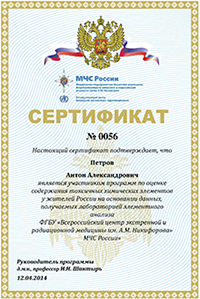It is important to know:
Why do people choose the Clinic of the Ministry of Emergency Situations?
Which steps necessary to do the test?
How to determine the amount of phosphorus in the human body
Dear friends!
This article is focused on phosphorus (P), a the chemical element, located under the number 15 in the periodic table. We all heard about fish being rich in this element.

Phosphorus is a non-metal element of white, yellow or red color, of plastic or powdery consistency.
The most common property of phosphorus is its capability of glowing in the dark. Materials all spoon baits, meant for winter fishing, are made of, include phosphorus for the obtaining the required properties.
It's generally accepted that phosphorus was discovered in 1669, when Hennig Brand derived the substance glowing in the dark in the course of distilling urine.
White phosphorus is a toxic, colorless, waxy mass which turns yellowish on the snow. It is readily oxidizable and inflammable. If ingested, it is highly toxic for the body and gets easily absorbed.
Red phosphorus is a powdery substance. Its insoluble form is nontoxic and can have a toxic effect on the body only qua dust.
Phosphorus compounds are used in industry, agriculture, metalworking, etc.
Speaking of food, in order to maintain the requires level of phosphorus in the body, it is necessary to include seafood, milk, meat, eggs, vegetables, porcini mushrooms, walnuts, cereals and especially rice into the diet.
Considering the role phosphorus plays in the body, it is worth highlighting its following major functions in:
- growing and recovery of the body;
- shaping and supporting bones, teeth, arthritis pain abatement, etc.
The average human diet actually exceeds the required limit of phosphorus sevenfold, thus the lack of phosphorus might be caused either by genetics or some diseases, current or previous.
It is especially important to watch out for uncontrolled intake of the vitamin complexes containing this trace element, since it might cause because some serious biochemical disturbance and the imbalance in the bioelemental status.
Taking a closer look at the body systems affected by phosphorus, we can distinguish the following:
- participation in the nervous system;
- intellectual and sexual functions;
- the shaping and supporting bone tissue.
Phosphorus absorbed in the body, comes with food qua phosphates, phospholipids and phosphoproteins.
Parathyroid glands are responsible for phosphorus metaboism in the body.
The lack of phosphorus can be observed in the following cases:
- parathyroid dysfunction;
- low digestible or indigestible vitamin D;
- rachitis and paradontosis;
- protein-free diets;
- diabetes, alkalosis, etc.
The lack of phosphorus in the body might also result from radiation therapy or radiation or, in some cases, from its increased consumption during lactation and child bearing.
It is important to keep in mind that it is impossible to determine the lack of phosphorus in the diet analyzing samples of blood or urine over a long stretch of time, since its lack gets replete with the deposition from bones and tissues.
There are no clearly defined criteria for detecting the lack of phosphorus and its diagnosing, yet we should mention the following symptoms:
- malaise and weakness;
- bone pain and paresthesia;
- poor appetite, etc.
Phosphorus can be generally prescribed as medication for:
- tuberculosis;
- bone and dental diseases;
- the nervous system dysfunction;
- parathyroid dysfunction;
- overwork and cardiac failure, etc.
Considering the serious diseases associated with the lack of phosphorus in the body, the following pathologies can be distinguished.
Hypophosphatemia, low blood phosphorus and an increased risk of osteoporosis, osteomalacia and the nervous system dysfunction.
The main symptoms of this pathology are associated with:
- ataxia and muscle weakness;
- anorexia and irritability;
- liver and cardiac failure.
The next genetic disorder associated with the lack of phosphorus is hypophosphataemic rickets.
This disease affects 1–2 years old children and manifests itself through the growth inhibition with pronounced deformity of a skeleton and mainly its lower limbs, which leads to a waddling gait.
This disease is associated with a genetic predisposition and characterized by lack of phosphorus, amino acids and bicarbonates causing pathologies of the bone tissue and skeleton.
This disease manifest itself through the following symptoms:
- bone and muscle soreness;
- retarded development and muscular hypotonia;
- hypofasphatemia and hyperphosphaturia, etc.
It is possible to identify the following reasons for the exceeded level of phosphorus in the body:
- vitamin D overdose;
- exceeded phosphate intake;
- disorder of parathyroid glands;
- renal failure, etc.
It is important to mind the phosphorus - calcium ratio, which theoretically should be 1 to 2. There should be twice as mach calcium as phosphorus in the body for maintaining its perfect trace-elemental balance.
People engaged in chemical and pharmaceutical industries should systematically monitor phosphorus, contained in their bodies and if its level gets exceeded, excrete it through detoxification.
The body gets intoxicated with phosphorus mainly through the skin and lungs.
Chronic phosphorism manifests itself through the following symptoms:
- poor appetite and headaches;
- atrophic rhinitis, bronchitis, tracheitis, etc.
Analyzing the requests made by the consumers regarding this element, we have detected the following variations:
• how to determine the amount of phosphorus present in the human body;
• how to determine the amount of phosphorus in the human body;
• how to check the level of phosphorus in the body;
• how to raise the level of phosphorus in the body;
• how to increase the level of phosphorus in the human body;
• how can I learn the level of phosphorus in the human body;
• how the level of phosphorus in the body can be determined;
• how to replete phosphorus in the body;
• how to find out the amount of phosphorus present in the human body;
• how to determine the limit of phosphorus for a child and an adult, etc.
Answering the question of “how to determine the amount of phosphorus in the human body?” it is worth focusing on the innovative method for determining the presence of vital and toxic trace elements in the body, i.e. the method of coupled plasma mass spectrometry also referred to as spectral analysis.
The demand for this research method, elaborated in the state Clinic of the Ministry of Emergency Situations, was conditioned by the lack of methods capable of determining a wide range of elements within a single study and getting a complete picture of their distribution in the body.
This method is capable of determining the correlation of toxic noxious and essential trace elements present in the body, detecting its weak points and avoiding all health problems in years to come.
Toxic trace elements get systematically accumulated in the tissues, organs, bones and other body structures, therefore it is impossible to detect their exact presence through studies of the organic samples such as urine, blood, cerebrospinal fluid, saliva, etc.
It also applies to the detection of the vital trace elements when their exact quantity needs to be determined in order to build an overall picture of the bioelemental status qua the aggregate of vital and toxic elements.
That is exactly why the unique laboratory of elemental analysis aimed at detecting and monitoring the presence of toxic trace elements in the human body of was launched within the Clinic of the Ministry of Emergency Situations in 2007. The service was initially meant for employees of the huge structure accountable to the Ministry of Emergency Situations.
The spectral analysis (you can learn more about the method by clicking this link http://www.mineralogram.com/bioelementnyystatus.html) is a unique method which provides the most accurate information both on vital and toxic trace elements, present in a human body, which makes it possible to study the wide range of indicators instead of focusing on a certain single chemical element.
You can look into an example of the study done through the method of the spectral analysis by clicking this link.
It is a matter of great importance, since the trace elements constitute a single system and the lack of some elements causes the accumulation of the others, which results in replacement of the certain elements with the other once.
As you might see, our project is fully devoted to the spectral analysis and its principle with regard to health control. We will gladly assist you at every step of this study, elucidate the obtained results and, if necessary, advise you on how to restore the elemental status of your body.
Our experts will be happy to answer any questions you may have regarding the method of spectral analysis!
The uniqueness of this method makes it possible to study samples sent from any part of the world as a usual letter. It is a truly unique tool of the health control.
Remember that the systematic control over the vital sighs it is the major step on the way to well-being and longevity.
We would like to thank you for your kind attention!
Yours faithfully, 33 Elementa.Ru
Publications
Is eating with a silver spoon bad for health of children and adults? Myth or real danger to the bodyRead >>
At the present review we do akcent on question: – “Why do patients choose the Clinic of the Ministry of Emergency Situations of Russia? ”.Read >>
The concept of the health control as a factor of the awareness of the body-related issues and the proper attitude towards themRead >>




